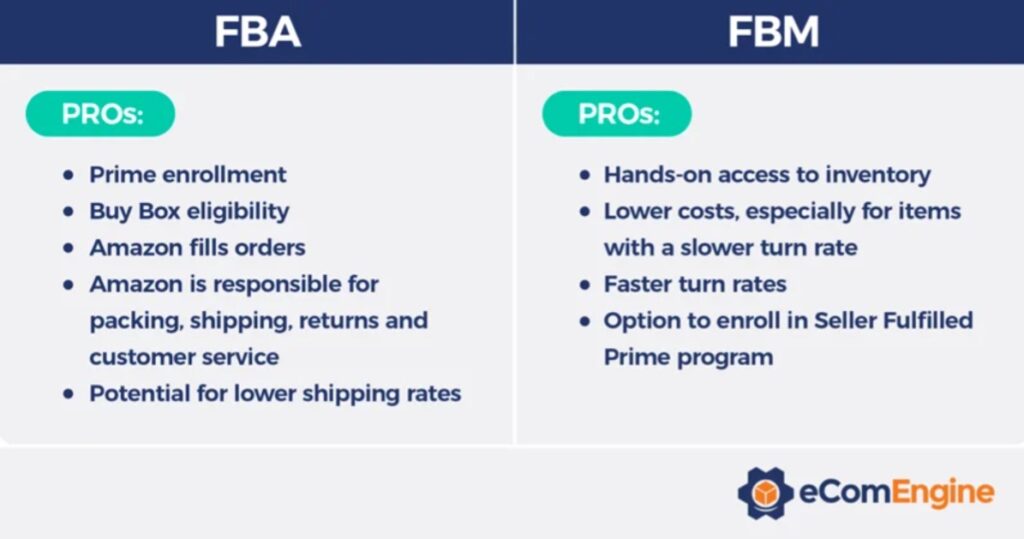Introduction
Amazon offers two primary fulfillment methods: Amazon FBA vs FBM. Choosing the right one can significantly impact your e-commerce success. This guide will compare the pros, cons, and costs of both options to help you make an informed decision.
Understanding Amazon FBA and FBM
What is Amazon FBA?
Fulfillment by Amazon (FBA) means Amazon handles inventory storage, packaging, shipping, and customer service on behalf of the seller.
What is Amazon FBM?
Fulfillment by Merchant (FBM) allows sellers to store, pack, and ship their products directly to customers without Amazon’s intervention.
Key Differences Between FBA and FBM
- FBA: Hands-off fulfillment, higher fees, faster shipping times.
- FBM: More control over inventory, lower fees, but increased responsibility for shipping and customer service.
Pros and Cons of Amazon FBA
Advantages of FBA
- Faster shipping with Prime eligibility.
- Amazon handles returns and customer service.
- Increased buy box chances due to best Amazon FBA course logistics network.
Disadvantages of FBA
- Higher fulfillment and storage fees.
- Less control over inventory management.
- Risk of long-term storage fees.
Pros and Cons of Amazon FBM
Advantages of FBM
- Lower fees and no long-term storage costs.
- Greater control over inventory and fulfillment.
- More flexibility with pricing and branding.
Disadvantages of FBM
- No automatic Prime eligibility.
- Requires handling shipping, customer service, and returns.
- May have lower sales conversions compared to FBA.
Cost Comparison: FBA vs. FBM
Fulfillment and Storage Costs
- FBA: Amazon charges for picking, packing, and storage.
- FBM: Sellers handle their own storage and packing, reducing fees.
Shipping and Handling Costs
- FBA: Amazon ships orders, typically at lower bulk rates.
- FBM: Sellers must negotiate their own shipping rates or use third-party logistics.
Additional Fees and Considerations
- FBA: Monthly storage fees and potential long-term storage fees.
- FBM: Potential additional costs for warehousing or third-party fulfillment services.
Which Model is Best for Different Types of Sellers?
Best for Beginners
- FBA is often easier for beginners since Amazon handles logistics.
Best for High-Volume Sellers
- FBA works best for scaling businesses that prioritize fast fulfillment.
Best for Low-Margin Products
- FBM may be a better choice for maximizing profit margins.
Best for Handmade and Unique Items
- FBM allows more flexibility in packaging and branding.
How to Decide Between Amazon FBA and FBM
Evaluating Your Business Needs
- Consider how much control you want over fulfillment and shipping.
Understanding Your Profit Margins
- Calculate all costs, including fees, shipping, and storage, to see which model is more profitable.
Considering Scalability and Convenience
- FBA is more scalable, while FBM allows for more customization and control.
Conclusion
Both Amazon FBA and FBM have their advantages and disadvantages. The best choice depends on your business model, budget, and long-term goals. By carefully evaluating costs and operational needs, you can select the fulfillment method that best suits your business.
Frequently Asked Questions (FAQ)
- Which is more profitable, FBA or FBM?
It depends on product type, fees, and business goals. FBA works well for high-volume sellers, while FBM is better for niche and low-margin products. - Can I switch from FBM to FBA later?
Yes, you can transition between fulfillment methods based on your business needs. - Does Amazon favor FBA sellers over FBM sellers?
FBA sellers often have a higher chance of winning the Buy Box due to Amazon’s logistics priority. - Is FBA worth it for small sellers?
It can be, especially if you want to scale quickly and avoid handling logistics yourself.
Do FBM sellers get Prime benefits?
Only if they qualify for Seller Fulfilled Prime, which requires meeting strict shipping standards.


